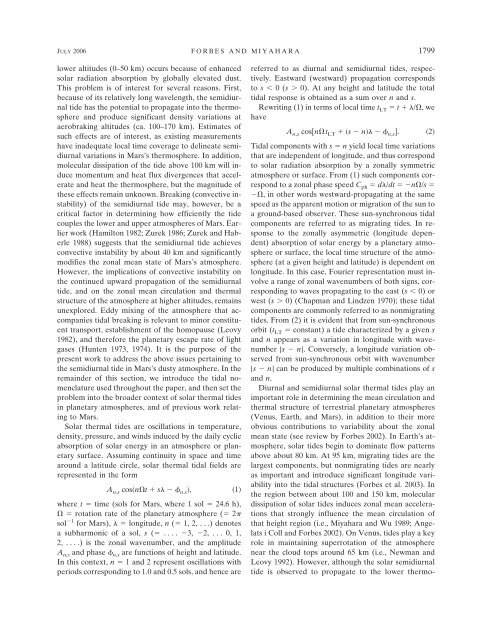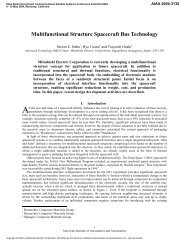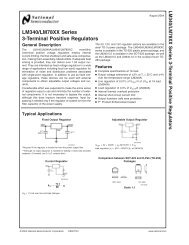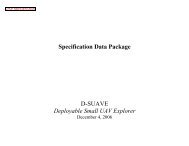Solar Semidiurnal Tide in the Dusty Atmosphere of Mars
Solar Semidiurnal Tide in the Dusty Atmosphere of Mars
Solar Semidiurnal Tide in the Dusty Atmosphere of Mars
- No tags were found...
Create successful ePaper yourself
Turn your PDF publications into a flip-book with our unique Google optimized e-Paper software.
JULY 2006 FORBES AND MIYAHARA 1799lower altitudes (0–50 km) occurs because <strong>of</strong> enhancedsolar radiation absorption by globally elevated dust.This problem is <strong>of</strong> <strong>in</strong>terest for several reasons. First,because <strong>of</strong> its relatively long wavelength, <strong>the</strong> semidiurnaltide has <strong>the</strong> potential to propagate <strong>in</strong>to <strong>the</strong> <strong>the</strong>rmosphereand produce significant density variations ataerobrak<strong>in</strong>g altitudes (ca. 100–170 km). Estimates <strong>of</strong>such effects are <strong>of</strong> <strong>in</strong>terest, as exist<strong>in</strong>g measurementshave <strong>in</strong>adequate local time coverage to del<strong>in</strong>eate semidiurnalvariations <strong>in</strong> <strong>Mars</strong>’s <strong>the</strong>rmosphere. In addition,molecular dissipation <strong>of</strong> <strong>the</strong> tide above 100 km will <strong>in</strong>ducemomentum and heat flux divergences that accelerateand heat <strong>the</strong> <strong>the</strong>rmosphere, but <strong>the</strong> magnitude <strong>of</strong><strong>the</strong>se effects rema<strong>in</strong> unknown. Break<strong>in</strong>g (convective <strong>in</strong>stability)<strong>of</strong> <strong>the</strong> semidiurnal tide may, however, be acritical factor <strong>in</strong> determ<strong>in</strong><strong>in</strong>g how efficiently <strong>the</strong> tidecouples <strong>the</strong> lower and upper atmospheres <strong>of</strong> <strong>Mars</strong>. Earlierwork (Hamilton 1982; Zurek 1986; Zurek and Haberle1988) suggests that <strong>the</strong> semidiurnal tide achievesconvective <strong>in</strong>stability by about 40 km and significantlymodifies <strong>the</strong> zonal mean state <strong>of</strong> <strong>Mars</strong>’s atmosphere.However, <strong>the</strong> implications <strong>of</strong> convective <strong>in</strong>stability on<strong>the</strong> cont<strong>in</strong>ued upward propagation <strong>of</strong> <strong>the</strong> semidiurnaltide, and on <strong>the</strong> zonal mean circulation and <strong>the</strong>rmalstructure <strong>of</strong> <strong>the</strong> atmosphere at higher altitudes, rema<strong>in</strong>sunexplored. Eddy mix<strong>in</strong>g <strong>of</strong> <strong>the</strong> atmosphere that accompaniestidal break<strong>in</strong>g is relevant to m<strong>in</strong>or constituenttransport, establishment <strong>of</strong> <strong>the</strong> homopause (Leovy1982), and <strong>the</strong>refore <strong>the</strong> planetary escape rate <strong>of</strong> lightgases (Hunten 1973, 1974). It is <strong>the</strong> purpose <strong>of</strong> <strong>the</strong>present work to address <strong>the</strong> above issues perta<strong>in</strong><strong>in</strong>g to<strong>the</strong> semidiurnal tide <strong>in</strong> <strong>Mars</strong>’s dusty atmosphere. In <strong>the</strong>rema<strong>in</strong>der <strong>of</strong> this section, we <strong>in</strong>troduce <strong>the</strong> tidal nomenclatureused throughout <strong>the</strong> paper, and <strong>the</strong>n set <strong>the</strong>problem <strong>in</strong>to <strong>the</strong> broader context <strong>of</strong> solar <strong>the</strong>rmal tides<strong>in</strong> planetary atmospheres, and <strong>of</strong> previous work relat<strong>in</strong>gto <strong>Mars</strong>.<strong>Solar</strong> <strong>the</strong>rmal tides are oscillations <strong>in</strong> temperature,density, pressure, and w<strong>in</strong>ds <strong>in</strong>duced by <strong>the</strong> daily cyclicabsorption <strong>of</strong> solar energy <strong>in</strong> an atmosphere or planetarysurface. Assum<strong>in</strong>g cont<strong>in</strong>uity <strong>in</strong> space and timearound a latitude circle, solar <strong>the</strong>rmal tidal fields arerepresented <strong>in</strong> <strong>the</strong> formA n,s cosnt s n,s ,where t time (sols for <strong>Mars</strong>, where 1 sol 24.6 h),rotation rate <strong>of</strong> <strong>the</strong> planetary atmosphere ( 2sol 1 for <strong>Mars</strong>), longitude, n ( 1, 2, . . .) denotesa subharmonic <strong>of</strong> a sol, s ( .... 3, 2, . . . 0, 1,2, ....) is <strong>the</strong> zonal wavenumber, and <strong>the</strong> amplitudeA n,s and phase n,s are functions <strong>of</strong> height and latitude.In this context, n 1 and 2 represent oscillations withperiods correspond<strong>in</strong>g to 1.0 and 0.5 sols, and hence are1referred to as diurnal and semidiurnal tides, respectively.Eastward (westward) propagation correspondsto s 0(s 0). At any height and latitude <strong>the</strong> totaltidal response is obta<strong>in</strong>ed as a sum over n and s.Rewrit<strong>in</strong>g (1) <strong>in</strong> terms <strong>of</strong> local time t LT t /,wehaveA n,s cosnt LT s n n,s .Tidal components with s n yield local time variationsthat are <strong>in</strong>dependent <strong>of</strong> longitude, and thus correspondto solar radiation absorption by a zonally symmetricatmosphere or surface. From (1) such components correspondto a zonal phase speed C ph d/dt n/s , <strong>in</strong> o<strong>the</strong>r words westward-propagat<strong>in</strong>g at <strong>the</strong> samespeed as <strong>the</strong> apparent motion or migration <strong>of</strong> <strong>the</strong> sun toa ground-based observer. These sun-synchronous tidalcomponents are referred to as migrat<strong>in</strong>g tides. In responseto <strong>the</strong> zonally asymmetric (longitude dependent)absorption <strong>of</strong> solar energy by a planetary atmosphereor surface, <strong>the</strong> local time structure <strong>of</strong> <strong>the</strong> atmosphere(at a given height and latitude) is dependent onlongitude. In this case, Fourier representation must <strong>in</strong>volvea range <strong>of</strong> zonal wavenumbers <strong>of</strong> both signs, correspond<strong>in</strong>gto waves propagat<strong>in</strong>g to <strong>the</strong> east (s 0) orwest (s 0) (Chapman and L<strong>in</strong>dzen 1970); <strong>the</strong>se tidalcomponents are commonly referred to as nonmigrat<strong>in</strong>gtides. From (2) it is evident that from sun-synchronousorbit (t LT constant) a tide characterized by a given sand n appears as a variation <strong>in</strong> longitude with wavenumber|s n|. Conversely, a longitude variation observedfrom sun-synchronous orbit with wavenumber|s n| can be produced by multiple comb<strong>in</strong>ations <strong>of</strong> sand n.Diurnal and semidiurnal solar <strong>the</strong>rmal tides play animportant role <strong>in</strong> determ<strong>in</strong><strong>in</strong>g <strong>the</strong> mean circulation and<strong>the</strong>rmal structure <strong>of</strong> terrestrial planetary atmospheres(Venus, Earth, and <strong>Mars</strong>), <strong>in</strong> addition to <strong>the</strong>ir moreobvious contributions to variability about <strong>the</strong> zonalmean state (see review by Forbes 2002). In Earth’s atmosphere,solar tides beg<strong>in</strong> to dom<strong>in</strong>ate flow patternsabove about 80 km. At 95 km, migrat<strong>in</strong>g tides are <strong>the</strong>largest components, but nonmigrat<strong>in</strong>g tides are nearlyas important and <strong>in</strong>troduce significant longitude variability<strong>in</strong>to <strong>the</strong> tidal structures (Forbes et al. 2003). In<strong>the</strong> region between about 100 and 150 km, moleculardissipation <strong>of</strong> solar tides <strong>in</strong>duces zonal mean accelerationsthat strongly <strong>in</strong>fluence <strong>the</strong> mean circulation <strong>of</strong>that height region (i.e., Miyahara and Wu 1989; Angelatsi Coll and Forbes 2002). On Venus, tides play a keyrole <strong>in</strong> ma<strong>in</strong>ta<strong>in</strong><strong>in</strong>g superrotation <strong>of</strong> <strong>the</strong> atmospherenear <strong>the</strong> cloud tops around 65 km (i.e., Newman andLeovy 1992). However, although <strong>the</strong> solar semidiurnaltide is observed to propagate to <strong>the</strong> lower <strong>the</strong>rmo-2













